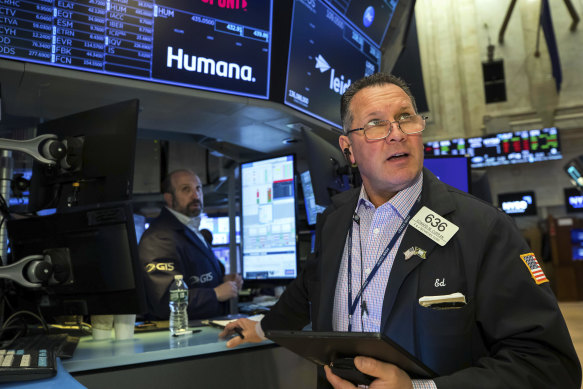Stocks fell in afternoon trading on Wall Street on Thursday as worries build that the US may be headed for a painful recession.
The S&P 500 is 0.9 per cent lower in early afternoon trade while the Dow Jones has shed 0.6 per cent and the Nasdaq has lost 1.1 per cent. The Australian sharemarket is set to open lower, with futures at 4.57am AEDT pointing to a fall of 22 points, or 0.3 per cent, at the open. The ASX added 0.6 per cent on Thursday.

Wall Street has retreated this week.Credit:NYSE
Every major index is on track for a weekly loss after the market kicked off the year with a two-week rally. Bond yields were steady, but have been moving broadly lower since the beginning of the year. Analysts expect the broader market to remain unsteady as investors try to get a clearer picture of inflation and the economy’s path ahead.
“It’s very reflective of the conflicting views that investors have with respect to where things are headed here in early 2023,” said Greg Bassuk, CEO at AXS Investments.
Reports showed weakness in several areas of the economy, including the housing industry and manufacturing in the mid-Atlantic region, though they weren’t quite as bad as expected and the job market appears to remain healthy. They follow worse-than-expected readings a day earlier on retail sales, a cornerstone of the economy, and industrial production.
The latest economic data paint a picture of an economy slowing under the weight of last year’s blizzard of rate hikes by the Federal Reserve. The central bank aggressively raised interest rates to purposely slow the economy and cool inflation. The strategy risks hitting the bakes too hard on economic growth and causing a recession.
Several major banks are forecasting at least a mild recession this year as the impact from the Fed’s rate increases reverberates through the economy. Inflation has been cooling, but prices are still stubbornly high on many items and are squeezing consumers.
The central bank has raised its key overnight rate to a range of 4.25 per cent to 4.50 per cent from roughly zero a year ago. The Fed will announce its next decision on interest rates February 1. Investors are largely forecasting a raise of just 0.25 percentage points next month, down from December’s half-point hike and from four prior increases of 0.75 percentage points.
The Fed has maintained that it won’t ease off its fight against inflation until it is sure that prices are cooling. It has also been closely watching several areas of the economy, including the labour market, to get a better sense of whether inflation is slowing. The latest weekly unemployment data shows that employment remains strong, which is good for workers but makes the Fed’s fight against inflation more difficult.
Stay connected with us on social media platform for instant update click here to join our Twitter, & Facebook
We are now on Telegram. Click here to join our channel (@TechiUpdate) and stay updated with the latest Technology headlines.
For all the latest Business News Click Here
For the latest news and updates, follow us on Google News.
